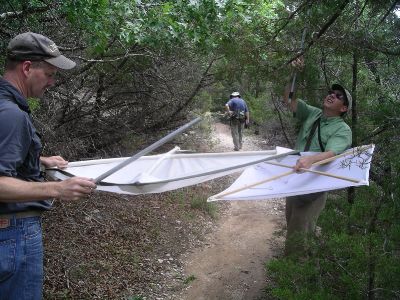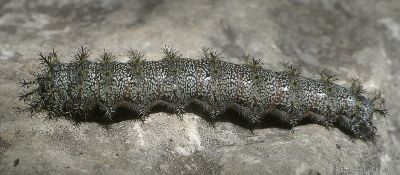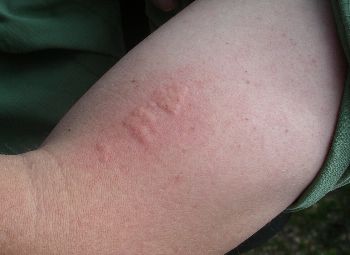
Dr. David Wagner and Mike using beat sheets to collect caterpillars
 Dr. David Wagner and Mike using beat sheets to collect caterpillars |
I am a member of an entomologically oriented club here in Texas called the Austin Butterfly Forum. This special interest group meets once a month and I've found the lectures given by various speakers to be most enjoyable. The emphasis is, of course, usually on butterflies, but all aspects of the arthropod world are fair game. We've had talks on bees, dragonflies, spiders, general insect taxonomy, and even dung beetles, to name a few topics. While most programs are presented by local folks, once a year our board member responsible for arranging the talks tries to get a nationally known professional. This year he succeeded in bringing Dr. David Wagner, one of the foremost experts on caterpillars, to our corner of the U.S. This occurred during the last weekend in April, well into insect season here in the South, so David was also able to do some collecting of live insects for his ongoing research studies.
Although our weather can be a bit unpredictable at that time of year, we were lucky enough to get two very good days for our expeditions. Storms on Sunday made it necessary to cancel the planned outing, but Saturday and Monday provided great conditions. Caterpillars are collected by using "beat sheets" which look like poorly designed white kites. However, when a square yard of fabric stretched over a simple wood frame is held under a branch while it is hit with a stick, all manner of odd creatures will fall into sight. Many larvae are cryptically colored and so it is very difficult to find them by just looking into the leaves (not to mention hard on the neck). By repeatedly striking the branches and making the caterpillars fall out, we found dozens of fascinating species in a very short time.
 the offending buck moth caterpillar |
One unfortunate incident happened on Saturday. Mike, professional entomologist and president of our club, was enthusiastically whacking the branches above his head when a large buck moth caterpillar fell, not into the sheet as intended, but onto his arm. While most caterpillars are harmless, a few possess poisonous spines for defense, and the buck moth is one of them. Mike's skin reacted almost immediately with a painful, swollen rash, but there was no need to call EMS.
 Mike's wounded arm |
Most of the time, though, was spent more pleasantly, finding and learning about all the unusual larvae that inhabit our central Texas environment. David was generous in sharing his vast knowledge and helping us learn more about immature lepidopterans, as well as being very personable and a joy to be with. We couldn't have asked for a better guide.
While I could not attend David's Monday evening talk about caterpillar defenses (due to a symphony rehearsal in which I was involved), I certainly was glad to participate in the field trips. An accompanying gallery of photos shows more images taken during our outings, including several interesting caterpillar species.